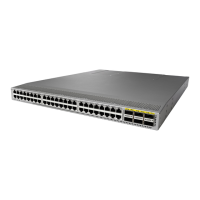switch# configure terminal
switch(config)# logging server 172.28.254.254 5
use-vrf default facility local3
switch# configure terminal
switch(config)# logging server 172.28.254.254 5 use-vrf management facility local3
Configuring syslog on a UNIX or Linux System
You can configure a syslog server on a UNIX or Linux system by adding the following line to the
/etc/syslog.conf file:
facility.level <five tab characters> action
The following table describes the syslog fields that you can configure.
Table 7: syslog Fields in syslog.conf
DescriptionField
Creator of the message, which can be auth, authpriv, cron, daemon, kern, lpr, mail, mark, news,
syslog, user, local0 through local7, or an asterisk (*) for all. These facility designators allow you to
control the destination of messages based on their origin.
Check your configuration before using a local facility.
Note
Facility
Minimum severity level at which messages are logged, which can be debug, info, notice, warning,
err, crit, alert, emerg, or an asterisk (*) for all. You can use none to disable a facility.
Level
Destination for messages, which can be a filename, a hostname preceded by the at sign (@), or a
comma-separated list of users or an asterisk (*) for all logged-in users.
Action
Procedure
Step 1 Log debug messages with the local7 facility in the file /var/log/myfile.log by adding the following line to the
/etc/syslog.conf file:
debug.local7 /var/log/myfile.log
Step 2 Create the log file by entering these commands at the shell prompt:
$ touch /var/log/myfile.log
$ chmod 666 /var/log/myfile.log
Step 3 Make sure that the system message logging daemon reads the new changes by checking myfile.log after
entering this command:
$ kill -HUP ~cat /etc/syslog.pid~
Cisco Nexus 3548 Switch NX-OS System Management Configuration Guide, Release 7.x
45
Configuring System Message Logging
Configuring syslog on a UNIX or Linux System

